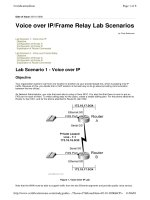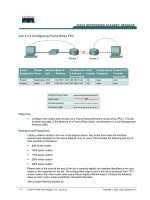Configuring Point-to-Multipoint OSPF Over Frame Relay
Bạn đang xem bản rút gọn của tài liệu. Xem và tải ngay bản đầy đủ của tài liệu tại đây (40.97 KB, 6 trang )
1 - 6 Semester 5: Advanced Routing v2.0 - Lab 4.6.3 Copyright 2001, Cisco Systems, Inc.
4.6.3: Configuring Point-to-Multipoint OSPF Over Frame Relay
Fa0/0 192.168.1.3 /24
Fa0/0 192.168.200.1 /24 Fa0/0 192.168.232.1 /24
DLCI 16DLCI 18
DLCI 16
DLCI 16
S0/0 .1
AREA 0
PVC
PVC
1/1
Frame Relay
Atlas 550
192.168.192.0 /24
S0/0
1/2 2/2
S0/0
.4
.2
SanJose3
London
Singapore
Alternate
:
Fa0/0 192.168.1.3 /24
Fa0/0 192.168.200.1 /24 Fa0/0 192.168.232.1 /24
DLCI 16DLCI 18
DLCI 16
DLCI 16
S0/0 .1
AREA 0
PVC
PVC
S0/0
S0/0
S0/1 S0/3
S0/0
.4
.2
SanJose3
London
Singapore
FR switch
192.168.192.0/24
2 - 6 Semester 5: Advanced Routing v2.0 - Lab 4.6.3 Copyright 2001, Cisco Systems, Inc.
Objective
In this lab, configure OSPF as a point-to-multipoint network type so that it operates
efficiently over a hub-and-spoke Frame Relay topology.
Scenario
International Travel Agency has just connected two regional headquarters to San Jose
using Frame Relay in a hub-and-spoke topology. You are asked to configure OSPF
routing over this type of network, which is known for introducing complications into OSPF
adjacency relationships. To avoid these complications, you must manually override the
Non-Broadcast Multi-Access (NBMA) OSPF network type and configure OSPF to run as
a point-to-multipoint network. In this environment, no DR or BDR is elected.
Step 1
Cable the network according to the diagram. (Note: This lab requires another router or
device to act as a Frame Relay switch.) The first diagram assumes that you will use an
Adtran Atlas 550, which is preconfigured. The second diagram assumes that you will
configure a router with at least three serial interfaces as a Frame Relay switch. See the
configuration at the end of this lab for an example of how to configure a router as a
Frame Relay switch. If desired, you can copy the configuration to a 2600 router for use in
this lab.
Configure each router’s FastEthernet interface as shown, but leave the serial interfaces
and OSPF routing unconfigured for now. Assign loopback interfaces to each router at
your discretion (be sure they are unique within your network).
Until you configure Frame Relay, you will not be able to use ping to test connectivity.
Step 2
SanJose3 acts as the hub in this hub-and-spoke network. It reaches London and
Singapore via two separate PVCs. Configure Frame Relay on SanJose3’s serial interface
as shown here:
SanJose3(config)#interface serial 0/0
SanJose3(config-if)#encapsulation frame-relay ietf
SanJose3(config-if)#ip address 192.168.192.1 255.255.255.0
SanJose3(config-if)#no shutdown
SanJose3(config-if)#frame-relay map ip 192.168.192.2 18 broadcast
SanJose3(config-if)#frame-relay map ip 192.168.192.4 16 broadcast
SanJose3(config-if)#ip ospf network point-to-multipoint
Note that this configuration includes frame-relay map commands, which are typically
used with Frame Relay subinterfaces. These commands are needed here so that you
can configure Frame Relay to handle broadcast traffic with the broadcast keyword.
Without this configuration, OSPF multicast traffic will not be forwarded correctly over this
Frame Relay topology.
Configure London’s serial interface; use IETF encapsulation:
London(config)#interface serial 0/0
London(config-if)#encapsulation frame-relay ietf
London(config-if)#ip address 192.168.192.2 255.255.255.0
London(config-if)#no shutdown
London(config-if)#frame-relay map ip 192.168.192.1 17 broadcast
London(config-if)#frame-relay map ip 192.168.192.4 17 broadcast
London(config-if)#ip ospf network point-to-multipoint
3 - 6 Semester 5: Advanced Routing v2.0 - Lab 4.6.3 Copyright 2001, Cisco Systems, Inc.
Finally, configure Singapore’s serial interface:
Singapore(config)#interface serial 0/0
Singapore(config-if)#encapsulation frame-relay IETF
Singapore(config-if)#ip address 192.168.192.4 255.255.255.0
Singapore(config-if)#no shutdown
Singapore(config-if)#frame-relay map ip 192.168.192.1 17 broadcast
Singapore(config-if)#frame-relay map ip 192.168.192.2 17 broadcast
Singapore(config-if)#ip ospf network point-to-multipoint
Verify Frame Relay operation with a ping from each router to the other two. Use show
frame-relay pvc and show frame-relay map to troubleshoot connectivity
problems. Rebooting the Frame Relay switch might also solve connectivity issues.
SanJose3#show frame-relay pvc
PVC Statistics for interface Serial0/0 (Frame Relay DTE)
Active Inactive Deleted Static
Local 2 0 0 0
Switched 0 0 0 0
Unused 0 0 0 0
DLCI = 17, DLCI USAGE = LOCAL, PVC STATUS = ACTIVE, INTERFACE =
Serial0/0
input pkts 91 output pkts 76 in bytes 13322
out bytes 14796 dropped pkts 10 in FECN pkts 0
in
BECN
pkts 0 out FECN pkts 0 out BECN pkts
0
in DE pkts 0 out DE pkts 0
out bcast pkts 50 out bcast bytes 9808
pvc create time 00:38:04, last time pvc status changed 00:01:18
DLCI = 18, DLCI USAGE = LOCAL, PVC STATUS = ACTIVE, INTERFACE =
Serial0/0
input pkts 61 output pkts 57 in bytes 10786
out bytes 14076 dropped pkts 4 in FECN pkts 0
in BECN pkts 0 out FECN pkts 0 out
BECN
pkts 0
in DE pkts 0 out DE pkts 0
out bcast pkts 30 out bcast bytes 8940
pvc create time 00:48:17, last time pvc status changed 00:03:31
SanJose3#show frame-relay map
Serial0/0 (up): ip 192.168.192.2 dlci 18(0x12,0x420), static,
broadcast,
IETF, status defined, active
Serial0/0 (up): ip 192.168.192.4 dlci 17(0x11,0x410), static,
broadcast,
IETF, status defined, active
4 - 6 Semester 5: Advanced Routing v2.0 - Lab 4.6.3 Copyright 2001, Cisco Systems, Inc.
Step 3
Configure OSPF to run over this point-to-multipoint network. Issue the following
commands at the appropriate router:
London(config)#router ospf 1
London(config-router)#network 192.168.200.0 0.0.0.255 area 0
London(config-router)#network 192.168.192.0 0.0.0.255 area 0
SanJose3(config)#router ospf 1
SanJose3(config-router)#network 192.168.1.0 0.0.0.255 area 0
SanJose3(config-router)#network 192.168.192 0.0.0.255 area 0
Singapore(config)#router ospf 1
Singapore(config-router)#network 192.168.232.0 0.0.0.255 area 0
Singapore(config-router)#network 192.168.192.0 0.0.0.255 area 0
Verify your OSPF configuration by issuing the show ip route command at each of the
routers:
London#show ip route
Gateway of last resort is not set
192.168.192.0/24 is variably subnetted, 3 subnets, 2 masks
C 192.168.192.0/24 is directly connected, Serial0/0
O 192.168.192.1/32 [110/64] via 192.168.192.1, 00:06:49,
Serial0/0
192.168.192.4/32 [110/128] via 192.168.192.1, 00:06:49,
Serial0/0
C 192.168.200.0/24 is directly connected, FastEthernet0/0
O 192.168.232.0/24 [110/129] via 192.168.192.1, 00:06:49,
Serial0/0
192.168.204.0/32 is subnetted, 1 subnets
C 192.168.204.1 is directly connected, Loopback0
O 192.168.1.0/24 [110/65] via 192.168.192.1, 00:06:50,
Serial0/0
If each router has a complete table, including routes to 192.168.1.0 /24, 192.168.200.0
/24, and 192.168.232.0 /24, you have successfully configured OSPF to operate over
Frame Relay.
Test these routes by pinging the FastEthernet interfaces of each router from London’s
console.
Finally, issue the show ip ospf neighbor detail command at any router’s console:
SanJose3#show ip ospf neighbor
Neighbor ID Pri State Dead Time Address Interface
192.168.200.1 1 FULL/ - 00:01:35 192.168.192.2 Serial0/0
192.168.232.1 1 FULL/ - 00:01:51 192.168.192.4 Serial0/0
SanJose3#show ip ospf neighbor detail
Neighbor 192.168.200.1, interface address 192.168.192.2
In the area 0 via interface Serial0/0
Neighbor priority is 1, State is FULL, 6 state changes
DR is 0.0.0.0 BDR is 0.0.0.0
Options 2
Dead timer due in 00:01:41
Index 2/2, retransmission queue length 0, number of
5 - 6 Semester 5: Advanced Routing v2.0 - Lab 4.6.3 Copyright 2001, Cisco Systems, Inc.
retransmission 1
First 0x0(0)/0x0(0) Next 0x0(0)/0x0(0)
Last retransmission scan length is 1, maximum is 1
Last retransmission scan time is 0 msec, maximum is 0 msec
Neighbor 192.168.232.1, interface address 192.168.192.4
In the area 0 via interface Serial0/0
Neighbor priority is 1, State is FULL, 6 state changes
DR is 0.0.0.0 BDR is 0.0.0.0
Options 2
Dead timer due in 00:01:56
Index 1/1, retransmission queue length 0, number of
retransmission 1
First 0x0(0)/0x0(0) Next 0x0(0)/0x0(0)
Last retransmission scan length is 1, maximum is 1
Last retransmission scan time is 0 msec, maximum is 0 msec
1. Is there a DR for this network? Why or why not?
There is no DR. Point-to-multipoint configuration creates a logical multiaccess network
over physical point-to-point links. Because each router has only one physical neighbor,
only one adjacency can be formed. No efficiency would be realized by electing a DR.
Router as Frame Relay Switch Configuration
The following example can be used to configure a router as the Frame Relay switch.
Frame-Switch#show run
version 12.0
service timestamps debug uptime
service timestamps log uptime
no service password-encryption
!
hostname Frame-Switch
!
ip subnet-zero
no ip domain-lookup
!
ip audit notify log
ip audit po max-events 100
frame-relay switching
!
process-max-time 200
!
interface Serial0/0
no ip address
no ip directed-broadcast
encapsulation frame-relay
clockrate 56000
cdp enable
frame-relay intf-type dce
frame-relay route 17 interface Serial0/2 16
frame-relay route 18 interface Serial0/1 16
!
interface Serial0/1
no ip address
no ip directed-broadcast
encapsulation frame-relay
clockrate 56000
cdp enable
frame-relay intf-type dce
frame-relay route 16 interface Serial0/0 18









